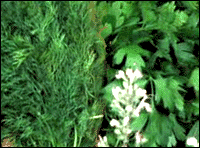Harvesting and Preserving Herbs
Created | Updated May 25, 2005

The earliest written records of herb1 use date from the papyrus scrolls of ancient Egypt. Not only were they used medicinally, but also in the mummification of the dead, and in the pyramids.
In the days of the Roman Empire the soldiers used herbs to flavour the salted and dried meat that they took on long marches. The further they travelled, the more herbs they discovered and began to use.
Witches used herbs that were very potent, some poisonous and hallucinogenic. Concoctions were smeared over the body, and the skin absorbed them, inducing trances.
Herbs were frequently used to disguise the taste of meat and other food that was difficult to preserve. Barely edible meals were made palatable by the generous helpings of herbs that were used in the cooking. They have also been used in making wine and beer, perfume candles and healing potions.
Harvesting
Use plants that are well established and upon which new growth is appearing. Pick healthy leaves from herbs just before they flower because this is when the flavour is stronger. If seedheads are required, they should be picked just before they completely ripen. Flowers should be picked with the stem when fully open and dry. A warm, dry day is best; after the dew has dried, but before midday when the sun is really hot and evaporates the essential oils. Take only a third of perennials, but annuals can be cut down almost to the ground. Be gentle and try to avoid bruising them as this also releases the oils.
Pick in such a way that you are also pruning. Encourage the plant to maintain its shape and vigour by taking the outside leaves from clump-formers, as new growth will come from the centre. Choose the creeping stems from invasive herbs, as this will help to contain them, and keep them looking tidy. Regular harvesting will encourage the plant to become bushy and put out new growth. Grow plenty of the ones that you use the most, so that the plants do not suffer from being cut too hard too often.
Only collect one herb at a time to avoid the flavours mingling. Use clean, sharp secateurs or scissors, and remember that damp herbs will deteriorate quickly - so never pick after the rain unless you intend to use them immediately. Herbs intended for medicinal use or for dried arrangements are best when fully mature. Herbs intended for the pot can be bitter when mature, so the young leaves are preferable; these will also benefit from having flowerbuds removed.
Preserving
There are two main ways of preserving herbs - drying and freezing. They can also be salted, made into herb vinegars, or alternatively into culinary herb oils, but this entry only deals with drying and freezing as these are the most common methods of preserving herbs. Herbs such as basil lose so much flavour when preserved that it is better to use them fresh only.
Drying
Herbs can be dried in a number of different ways - in a microwave, in a warm, airy room or even in an airing cupboard. They can be hung up or laid on a rack. The best way to dry them is generally whatever is most convenient to the person doing the drying, although there are some benefits to doing certain herbs a certain way. Hanging them will mean that they pick up dust and dirt, especially in cities.
Hanging herbs up in small, upside-down bunches works well - an airing cupboard will speed the process and help to retain flavour as they will be away from the flavour-destroying light. Drying on a muslin2-covered cake rack, turning them daily, is the most efficient method. The herbs will be dry and crisp (not brittle), but still green when they are done. They shouldn't be washed first as they might rot. Plants can take anything from a few days to three weeks to dry.
To use the microwave, rinse first and pat dry. Use the low setting for two to three minutes, checking every 30 seconds. This method is only recommended for herbs that contain so much essential oil that the loss during this process is not noticeable.
Freezing
Freezing is very simple and is a method that can be used on all herbs, especially those that lose their flavour when dried. Although there is only one place this can be done - a freezer - there are a few different ways to do it. The herbs should be washed. Put small quantities in polythene bags and then into boxes to prevent damage, or chop the herbs into small pieces and put into ice cube trays with water. Use as and when needed, within six weeks. If a longer storage time is needed, they should be blanched first. They can then be stored for six months.
Storing
Strip the leaves from the stems and store in airtight jars as soon as they are dry, otherwise they will start to reabsorb moisture. Dark glass or ceramic is best to preserve the flavour, but clear glass can be used as long as they are kept in the dark. Do not crush or chop until just before they are to be used, otherwise they lose their flavour.
Any herbs that you still have after a year should be thrown away, so all storage vessels should be labelled with the herb's name and the date it was stored.

